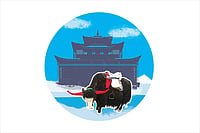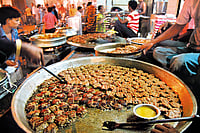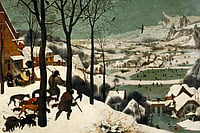The Crocus sativus is a splendid botanical curiosity, and I wish to take nothing away from it. But it does have an annoying habit of stirring up a tsunami in a kahwa cup. Even the English language bleeds, dyes and stains its character, accusing it, rather liberally, of colouring food, faith and folly in moral monochromes. I do no such thing, of course. And yet, the story of saffron is not easily told. So here’s a suitably obscure, theatrical episode to unpack its history for the flock.
Jobst Findeker was a marked man. An #anti-national in 15th century Nuremberg, who should have prayed for rain. Hard, heavy, heaven-splitting, hell-clogging rain. But the unlucky sod was no rainmaker, just a garden-variety thug. A thug who had escaped yet another outbreak of Black Death in the city, but not its saffron brigade. One that eventually tied him to a stake and set him on fire in 1444. Him and his ‘precious’ load of ersatz zafaran, all up in cautionary, odourless, mockingly orange-red flames.
In Nuremberg, adulterating saffron was the ultimate breach of faith. One that demanded a spectacle, a sacrifice. The kind that people in the Middle Ages were unusually drawn to, like people in their middle ages to a U2 concert today. But to fully understand the import of the Nuremberg laws, and ideas of purity and defilement, control and extermination, blood and honour, it’s a good idea to zoom out a little…man or woman—after Findeker, it was Elss Pfagnerin who was buried alive with her impure wares—the saffron police, or Safranschau, could burn or bury the guilty at will. They could do so in a free imperial city of the Holy Roman Empire. Not to put too fine a point on it, let it also be noted that this saffron-red sweep in Nuremberg began a full 158 years before the country’s first beer purity laws were even crafted. We’re talking about beer laws. In Germany! Laws that were more lager than ale, really, and outlasted the ones for saffron. Laws that called for the confiscation of botched-up beer barrels, not a hitchhike across the Hades on a stake.

Back home in Hindustan, of course, saffron was always dear. Use a pinch, not a pound. Sprinkle, but sparingly, on biryanis and barfis, on Eid and Diwali, and at least once every twelve years, not so sparingly on Bahubali at Shravanabelagola. Anyone who has ever wanted to stay on the ‘right’ side of history in this country has valued the value of saffron, a spice that is harvested by hand, like it was 2,000 years ago. Plucked carefully, strand by strand, from a papery purple flower that barely blooms in Kashmir for two weeks every fall. An orange-red strand so ephemeral, so fragile—like peace in the Valley— it belies the power it wields.
And yet, as the most consistently expensive spice in the world, still dearer than gold, powerful it must be. For where there’s paisa, there’s power, and where there’s power, there’s a priest and a pulpit—or in this instance, priests and pulpits, in plural. Grown in Pampore, near Srinagar, by Muslim farmers for kitchens and temples of every faith in India and overseas, there are many holy men who claim they got here first, bringing with them the earliest specimens of the Crocus sativus corms.
To this day, local farmers send up a prayer to the Sufi ascetics of Khwaja Masood Wali and Hazrat Sheikh Shariffudin in a golden-domed shrine before the harvest begins in late autumn or harud, a season of golden yellows and flaming oranges, tucked between the snow whites of winter and the impossible greens of summer. A season almost chromologically customised to celebrate saffron. Farmers believe that about 800 years ago, Wali and Shariffudin found their way to the valley and promptly fell ill, before a local tribal chief found them a cure and was gifted a bulb of saffron for his troubles. It’s a charming story with a charming end. But Chinese Buddhists would have none of it. They suggest Madhyantika, an arhat Buddhist missionary planted the Crocus in Kashmir in 5th century BC, nearly a full millennium before the monks wandered in. A claim that Daniel Lak then goes on to refute in More from Our Correspondent, an anthology of dispatches by BBC correspondents, where he and “Kashmir’s more secular historians” claim that saffron finds mention in ancient tantric Hindu texts, and was cultivated by indigenous people centuries before the ‘foreigners’ set foot here.
All these stories of origin appear to have certain conclusions in common. Generally, everyone wants to be first, no matter what the prize is. Generally, when it comes to Kashmir, we rarely agree on anything. And generally, it has been important historically, from day one, whenever that might have been, to stake a claim on saffron as a spice, an asset, a way of life for the faithful… And by extension, a colour, an ideology.
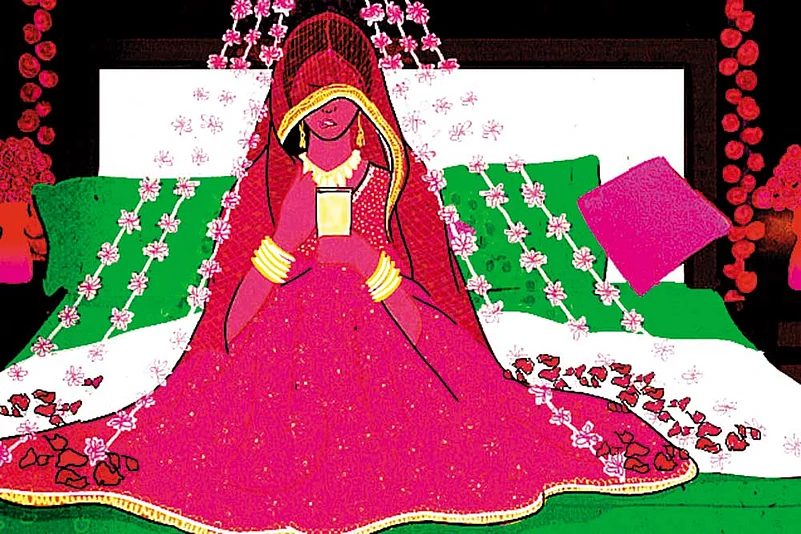
The greatest ideology, the religion of all religions in India, though, is colourless, even if it isn’t benign. Some call it Convenience—sometimes, conveniently confused with syncretism and progressiveness. In fact, such is the power of the capital C, even the most rabid fundamentalists are found faltering at its threshold. Wealthy Jain devotees of Gommateshwara, for instance, think nothing of sourcing the best saffron from Pampore, ‘tainted’ by the touch of Muslim farmers and their extended families, to consecrate their gods for the Mahamastakabhisheka, a word as wide as the statue of Bahubali is tall.
Kumkum, Sanskrit for saffron, is also used to anoint almost all Hindu deities—which is perhaps why the Krishna temple at Guruvayur in Kerala is one the largest consumers of saffron, buying it by the kilos from Kashmir, even as it turns away non-Hindus and Yesudas from its doors. In her book The Flavour of Spice Marryam H. Reshii reminds us that, “Almost all priests throughout the country make the Navgraha or grid of nine squares (representing the nine planets), for every puja, whether it’s for a new house or office space or for the success of a Bollywood film, and invite the gods by offering saffron paste. It was saffron that lent boondi laddoo, the most common prasad all over the country, its signature colour. In Tirupati, till today, laddoos have a small quantity of real saffron.”
But even as the proverbial laddoo crumbles, surely splitting hair over saffron in food is several shades better than saffronising it on balance. It’s one thing for practising Hindu guests, for instance, to feign ignorance about the ‘Muslimness’ of Indian saffron when a Rajasthani Rajput offers them a drink of Kesar Kasturi—a drink in which the addition of hunted musk or kasturi should cause more offence anyway—and it’s quite another to sink their teeth into suar ka soola, a shikari’s dish of barbecued pig or wild boar.
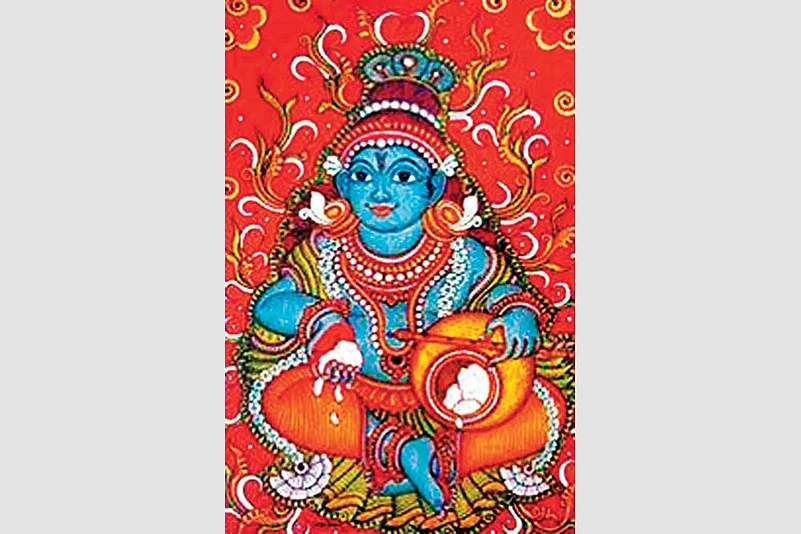
Speaking of pigs and all things forbidden by the devil and the divine, let’s take a paragraph or two to reflect on dietary injunctions of the porcine variety. Let’s digress a little like Christopher Hitchens did in the third chapter of his book, God is Not Great: ‘A short Digression on the Pig; or, Why Heaven Hates Ham’ to ask why “the designer of all things conceived such a versatile creature and then commanded its higher-mammal creation to avoid it altogether or risk his eternal displeasure”.
Hazard any ungodly guesses? A surgeon-writer friend of mine did hazard a guess once, stumbling upon the answer almost by accident under the cold white light of a cold white OT, I presume…. No, it’s not the fear of filth or the fear of disease, nor is it the swinish proclivity of some pigs to eat their own piglets or excreta. But something more primordial, more familial, it would seem. “One may note,” says Hitchens, “that children if left unmolested by rabbis and imams are very drawn to pigs, especially to baby ones, and that firefighters in general do not like to eat roast pork or crackling. The barbaric vernacular word for roasted human in New Guinea and elsewhere was ‘long pig’: I have never had the relevant degustatative experience myself, but it seems that we do, if eaten, taste very much like pigs.”
If that hasn’t put you off your dinner already, fry up some bacon and pull up a chair. For taboo and taste share more than just two letters in the English alphabet. And concepts of purity and piety are as old as religion itself. Concepts that are dictated by decisions that may have been made for us, the 21st-century laddoo-lotus eaters, sometime in Iron Age, by someone with bad teeth and overused kneecaps. And yet, we follow them in letter and spirit and cooking oil choices like they were tossed up for us at breakfast—eggs to order, anyone?
Depending on who you ask (race, religion, caste, eccentricities) and what time of the year you ask (season, festivals, fasts, follies), you can be sure you’ll be offending or defending someone’s dietary choices anyway in this country. So relax and pass the bacon. And while you’re at it, pre-book a Hindu meal for your next flight to Houston. (Howdy?) If you haven’t caught on already, inclusions and exclusions of the dietary kind are not by divine but human design. Vegetarianism, for instance, is widely understood to be a reaction to the rise of new religions like Buddhism and Jainism at the turn of the millennia, an attempt to reclaim virtue, presumably, by more pious men with bad teeth and knock knees.
The kind of men who would have approved had they known that India’s best-known brand of Crocus sativus, Baby Brand Saffron, gives the ‘baby’ in its name short shrift on its website. It also manages to undermine every Bollywood classic ever made with a glass of kesar doodh quivering in the hennaed hands of a bride—an important conjugal and cinematic rite of passage, before the camera pans out to focus on quivering strings of tuberoses instead. If you pay close attention—someone has to!—the Baby Brand website lists out not one but 10 crucial benefits of saffron—from depression to acidity, insomnia to cancer, asthma to fever (“it contains the compound ‘crocin’”, a carotenoid that has nothing in common with paracetamol tablets by the same name, except maybe an overeager content writer). All this while never once alighting on the word ‘aphrodisiac’, or even hinting at how the babies crawling all over the homepage are made. Such saffronisation of saffron is patently cause for double damnation and the eternal displeasure of people of all faiths. But until we arrive at the last judgement or a heaven with ham, I’d say, keep calm and kahwa on.
(Soity Banerjee is a Delhi-based journalist. Views are personal.)


















